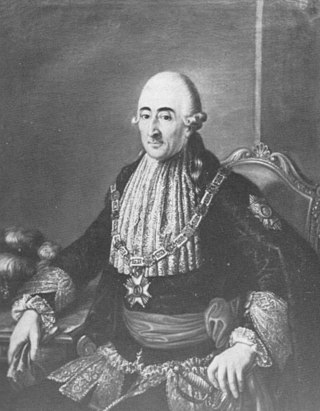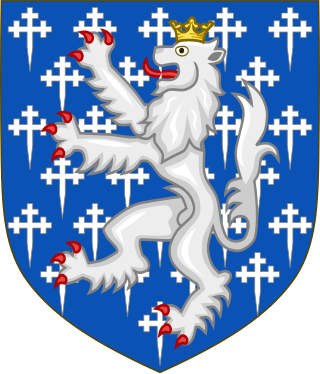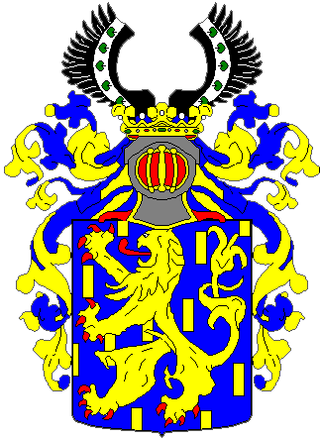Related Research Articles
Emicho was a count in the Rhineland in the late 11th century. He is also commonly referred to as Emicho of Leiningen or Emich of Flonheim, and not to be confused with Bishop Emicho of Leiningen. In 1096, he was the leader of the Rhineland massacres which were a series of mass murders of Jews that took place during the People's Crusade.

The House of Leiningen is the name of an old German noble family whose lands lay principally in Alsace, Lorraine, Saarland, Rhineland, and the Palatinate. Various branches of this family developed over the centuries and ruled counties with Imperial immediacy.

Prince Karl Emich of Leiningen, also known by his Orthodox Russian name Nikolai Kirillovich Romanov, and recognized with the regnal name Emperor Nicholas III by Monarchist Party supporters of the Imperial Throne, is the eldest son of Emich, 7th Prince of Leiningen and his wife, Duchess Eilika of the Grand Duchy of Oldenburg, and is an elder brother of Andreas, 8th Prince of Leiningen.
Moritz Hermann von Limburg, count of Limburg Stirum, was the second reigning count of the branch Limburg-Styrum-Styrum.

Carl Friedrich Wilhelm, Prince of Leiningen was a Prince of the Holy Roman Empire and the first ruler of the Principality of Leiningen.

Emich Carl, Prince of Leiningen was the reigning Fürst of the Principality of Leiningen. After his death, his widow, Princess Victoria of Saxe-Coburg-Saalfeld, married a son of George III of the United Kingdom and became the mother of Victoria, Queen of the United Kingdom.

The title of Prince of Leiningen was created by the Holy Roman Emperor Joseph II, who elevated Carl Friedrich Wilhelm, Count of Leiningen-Dagsburg-Hardenburg to the rank of Reichsfürst on 3 July 1779. Together with all other titles of nobility in Germany, it was abolished with the 1919 Weimar Constitution.

Simon III of Sarrebrück, Simon III von Saarbrücken (Saarbrücken-Leiningen) was the Count of Saarbrücken (de) from 1207 until his death, about 1240.

Johann Ernst of Nassau-Weilburg was an Imperial Generalfeldmarschall, from 1675 to 1688 Count and from 1688 until his death Prince (Fürst) of Nassau-Weiburg.

Count Christian Karl Reinhard of Leiningen-Dagsburg-Falkenburg was a German nobleman.

The County of Leiningen consists on a group of counties, which were ruled by the Leiningen family.
Johann Karl August, Count of Leiningen-Dagsburg-Falkenburg was a German nobleman. By descent, he was Count of Leiningen and Dagsburg, by heritage, he was Lord of Broich and Bürgel.
Countess Johanna Magdalene of Hanau-Lichtenberg was a daughter of Johann Reinhard II of Hanau-Lichtenberg (1628–1666) and the Countess Palatine Anna Magdalena of Birkenfeld-Bischweiler (1640–1693).

The County of Dagsburg with its capital Dagsburg existed in Lorraine from 11th to 18th centuries when the area was still part of Holy Roman Empire.
Charles of Hesse-Wanfried, was a Landgrave of Hesse-Wanfried. He was the second son of Landgrave Ernest of Hesse-Rheinfels and Maria Eleonore of Solms-Lich.
Emich Christian of Leiningen-Dagsburg was, by descent, Count of Leiningen and Dagsburg and, by inheritance, Lord of Broich, Oberstein and Bürgel.

Count William Wirich of Daun-Falkenstein was a German nobleman. By descent, he was a Count of Falkenstein; by inheritance, he was Lord of Broich and Bürgel.
Emicho I, Count of Nassau-Hadamar, was the second son of Count Otto I of Nassau and his wife Agnes, the daughter of Count Emich IV of Leiningen-Landeck. Emicho was the founder of the elder line of Nassau-Hadamar. He was a cousin of King Adolf of Germany. He and his brother Henry fought on Adolf's side in the Battle of Göllheim on 2 July 1298.
Marie-Christine is a given name. Notable people with the name include:

Nassau-Hadamar is the name of two side lines of the Ottonian main line of the House of Nassau. The older line of the counts of Nassau-Hadamar existed from 1303 to 1394; the younger line existed from 1607 to 1711 and received the hereditary title of prince in 1652.
References
- ↑ Emich Name Meaning: Dictionary of American Family Names as cited by ancestry.com